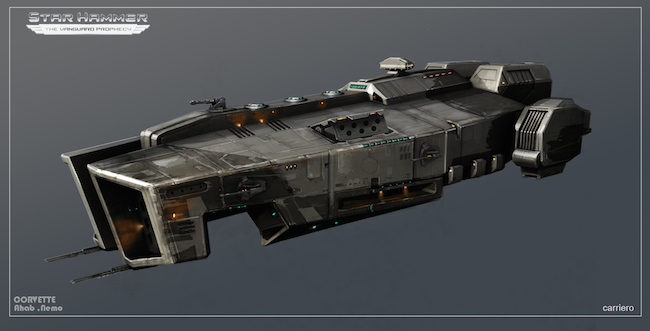
Star Hammer: The Vanguard Prophecy is a follow-up to Black Lab Games debut title, Star Hammer Tactics, which was originally released in 2010. The first game in the series had a unique and simplified take on tactical space combat, but with his latest project, Perth-based developer, Paul Turbett, hopes to take the sequel to that next level.
In an effort to highlight Perth’s local talent, we reached out to Paul to tell us more about his exciting new project!
Could you tell us a little bit about Black Lab Games? You’re a Perth-based studio, right?
Paul: Yes, we are based on Perth. I started the company in 2008 and it’s been mostly a part-time thing for me until recently. We launched a game called Star Hammer Tactics in 2010/2011, a casual strategy game, which was released on PSP, iPad and PC. Only the PC version is still available, however.
In April this year, we received a grant from the Australian Interactive Games Fund, which has been really helpful in assisting us to get our games up to the next level of production quality.
I’m currently working full-time on the new game in the series, and have four other awesome game developers helping out in various capacities, from narrative and design to 3D and UI art. We are outsourcing the audio and music to a local audio outsourcing outfit called The Otherworld Agency, who I highly recommend.
What would you say is the primary source of inspiration behind the Star Hammer series?
Paul: Well, there are actually quite a few sources of inspiration. I’m a huge fan of sci-fi, in all formats. I read sci-fi books, and watch sci-fi TV and movies, as well as play sci-fi games. So, there are certainly a large number of influences for the sci-fi themes of the Star Hammer series; from Neal Asher’s Agent Cormac series to Star Trek Voyager and a lot of other stuff in between. The gameplay is a mix of inspiration too, from pen & paper RPGs to Elite.

How would you explain “Star Hammer: The Vanguard Prophecy” to someone new?
Paul: It’s like a game of chess, set in space, between armed-to-the-teeth spaceships and weird aliens.
As this is a sequel, could you tell us how the series has evolved from your previous game?
Paul: Star Hammer Tactics, from a game design viewpoint, was an attempt to make a really simplified strategy game. Something that could be learnt quickly, but provide a lot of depth in the gameplay. With Star Hammer: The Vanguard Prophecy, we are going in quite a different direction, adding a lot more layers of depth to the gameplay. There will be significantly more options available in battle, both to the ships that the player controls, and the aliens that you are fighting against.
Are you considering a narrative component in this game, too? If so, could you tell us about it?
Paul: Definitely. The short version of the back-story is that it’s the 23rd century and mankind has had to abandon Earth because of environmental degradation. A convey of massive transports takes 1 million people to a star system called Gleise 581 roughly 20 million light years away from old Earth. Colonies are established, and everything is looking okay until an encounter with space-based life-form – called the nautilids – starts a turf war over the planet. “Star Hammer: The Vanguard Prophecy” is set 14 years after the First Contact War with the nautilids.
What do you feel makes this game stand apart from other well-known titles in the genre?
Paul: The core gameplay is tactical space combat. We actually haven’t found many games that have that as a focus.
Most RTS’ are really action games, rather than true strategy games. Most true strategy games, i.e the 4X genre, have combat as something you are quite disconnected with.

The visuals have been completely overhauled, tell us about some of the methods you’re using?
Paul: Well, first, we’ve got some excellent artists working on the game. Star Hammer Tactics had a tiny art budget, and to be honest, it shows. The current team all work remotely, but meet up weekly for a production meeting where we discuss the progress we’ve made and what we want to get done during the week. Our art pipeline starts with 2D and 3D concepts, which are then turned onto high-quality real-time 3D models. The game is developed in the Unity3D engine, and we’ve developed a lot of custom shaders to make the 3D art look it’s best in-game. We recently posted more information (with pictures) on the blog.
What has been your biggest challenge so far since you began working on the sequel?
Paul: Space is 3D, but most games take place in a 2D playspace. It’s been an interesting challenge finding a way to use the 3rd dimension whilst still making the user interface manageable and not frustrating.
Can you share something new about the game that we can share with our readers
Paul: We are trying to innovate they way turn-based strategy games play out. We are taking the best bits of turn-based and real-time systems and making a system we call “WEGO”. After giving your ships orders, you click the play button and game simulates yours and the opponent’s moves in real time.
What is platform/release timeframe you’re aiming for, and how can we support the game?
Paul: We are targeting PC/Mac first and foremost. Release timing is not something we can say much about at the moment. If the game sounds interesting, you can keep tabs on development via our Facebook, Twitter, or Tumblr.











